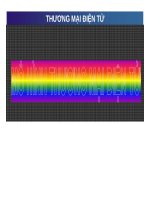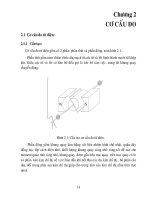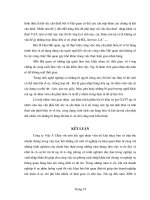Slide điện tử tương tự chapter 2 bjt
Bạn đang xem bản rút gọn của tài liệu. Xem và tải ngay bản đầy đủ của tài liệu tại đây (3.1 MB, 103 trang )
.c
om
ng
co
an
th
cu
u
du
o
ng
CHAPTER 2:
BIPOLAR JUNCION TRANSISTOR
DR. PHAM NGUYEN THANH LOAN
Hanoi, 9/24/2012
CuuDuongThanCong.com
/>
Contents
.c
om
2
Structure and operation of BJT
Different configurations of BJT
Characteristic curves
DC biasing method and analysis
ng
co
an
th
ng
du
o
AC signal analysis
Impact of other parameters (temperature, leakage
currents)
u
Base bias
Collector-feedback bias
Voltage divider bias
cu
The content of these slides are based on the book titled “Electronics Devices and Circuit theory of
Robert Boylestad”
CuuDuongThanCong.com
/>
Structure and operation of BJT
.c
om
3
BJT structure
th
an
ng
BJT :Bipolar Junction Transistor
2 kinds of BJT: NPN & PNP
3 terminals: E, B và C
E: Emitter; B: Base, C: Collector
Base located in the middle:
thinner than E & C; and lower
dope
co
cu
u
du
o
ng
CuuDuongThanCong.com
/>
Structure and operation of BJT
.c
om
4
Bias condition for 2 junctions: JBE & JBC
Junction BE in forward bias:
electrons (e) move from E region
to B region to create the current IE
(diffusion current; flow of
majority carriers)
Junction BC in reverse bias: e
that moved from E to B then
move from B to C to create the
current IC (drift current, flow of
minority carriers)
The combination of some
electrons with holes in B region
creates the current IB
So: IE = IC + IB
cu
u
du
o
ng
th
an
co
ng
CuuDuongThanCong.com
/>
Structure and operation of BJT
BJT symbol
ng
co
IE
cu
u
du
o
IB
th
an
IC
3 terminals: B, E và C
Arrow instructs the current
direction between B & E
Conventional current is the
flow of positive charges
(holes)
NPN: B E
PNP: E B
ng
.c
om
5
CuuDuongThanCong.com
/>
Technical parameters
.c
om
6
IE = IC + IB
IC = βIB
β = 100 ÷ 200 (may be higher)
β is DC current gain
IC = αIE + ICBO
ng
IC ≈ αIE (neglect leakage ICBO)
α = 0.9 ÷0.998.
α is DC current transfer coefficient
cu
u
du
o
ng
th
an
co
CuuDuongThanCong.com
1
/>
Technical parameters
IE = IC + IB
IC = β*IB
β = 100 ÷ 200 (may be higher)
β is DC current gain
IC = αIE + ICBO
cu
u
du
o
ng
th
an
co
ng
.c
om
7
CuuDuongThanCong.com
IC ≈ αIE (neglect leakage ICBO)
α = 0.9 ÷0.998.
α is DC current transfer coefficient
1
/>
BJT as an amplifier
Different amplifier configurations
Look at the input and output to distinguish these
configurations
cu
u
Configuration
BC
EC
CC
du
o
ng
th
Common emitter (CB)
Common base (CB)
Common collector (CC)
co
ng
3 configurations
an
.c
om
8
CuuDuongThanCong.com
Input
E
B
B
Output
C
C
E
/>
CE configuration
E is used in common for
in and out
co
ng
.c
om
9
th
an
ng
re=26mV/IE
Output: Ic= βIb
cu
u
du
o
Input: re is considered as
AC resistor of diode BE
9
CuuDuongThanCong.com
/>
10
.c
om
CE configuration – small signal
Zi = Ube/Ib ≈ βIbre/Ib ≈ βre
(~ n100Ω – nKΩ)
Z o = ro ∞
(ignore in re model)
Av = - RL/re (ro ∞)
Ai = Ic/Ib = β
Characteristics
+ Zi, Zo average
+ Av, Ai high
cu
u
du
o
ng
th
an
co
ng
10
CuuDuongThanCong.com
/>
Characteristic curves: CE
u
du
o
ng
th
an
co
ng
Input and output characteristic curves of CE configuration
cu
.c
om
11
11
CuuDuongThanCong.com
/>
Characteristic curves: CE
0
bias IC increases gradually
VCE >0.7V: Junction BE is in
FB and Junction BC in reverse
IC = β*IB
cu
u
du
o
ng
th
an
co
ng
.c
om
12
CuuDuongThanCong.com
/>
CB configuration
B is used in common for
in and out
co
ng
.c
om
14
Input: re is considered as
AC resistor of diode BE
re=26mV/IE
Isolation between in and
out
Output: Ic=αIe
cu
u
du
o
ng
th
an
14
CuuDuongThanCong.com
/>
CB configuration
du
o
ng
th
an
co
ng
.c
om
15
(nΩ-50 Ω)
Z i = re
2)
Zo = ro ≈ ∞ (nMΩ)
3)
Av = αRL/re ≈ RL/re quite big, Uo & Ui in phase
4)
Ai = -α ≈ 1
cu
u
1)
15
CuuDuongThanCong.com
/>
Characteristic curves: CB
u
du
o
ng
th
an
co
ng
Input and output characteristic curves of CB configuration
cu
.c
om
16
CuuDuongThanCong.com
/>
CC configuration
Similar to CE configuration
du
o
ng
th
an
co
ng
Refer to Electronic Devices – Thomas Floyd
u
cu
.c
om
17
17
CuuDuongThanCong.com
/>
Limits of operation
.c
om
18
Two limits:
cut-off
region
Saturation region
cu
u
du
o
ng
th
an
co
ng
CuuDuongThanCong.com
/>
Cutoff and saturation
Cutoff state
Saturation state
u
du
o
ng
th
an
co
ng
cu
.c
om
19
CuuDuongThanCong.com
/>
ng
.c
om
20
cu
u
du
o
ng
th
an
co
DC bias:
DC operating point & DC load line
CuuDuongThanCong.com
/>
DC bias
A transistor must be properly biased in order to operate as
ng
.c
om
21
an
th
DC bias can be considered as supply power to BJT so that
NPN: VE < VB < VC (JE: in Forward; JC: in Reverse bias)
PNP: VE > VB > VC
DC bias is characterized by Q-point (DC operating point)
and DC load line
u
cu
du
o
ng
co
an amplifier
CuuDuongThanCong.com
/>
DC bias
NOTES: REMEMBER some equations:
VBE ≈ 0,6 ÷ 0,7V (Si) ; 0,2 ÷ 0,3(Ge)
IE = IC + IB IC = βIB
IC ≈ αIE
There 3 types of bias circuits
an
co
ng
.c
om
22
Base bias
Collector-feedback bias
Voltage divider bias
u
Question: How many amplifier circuits can be
designed?
cu
du
o
ng
th
CuuDuongThanCong.com
/>
3 types of baising
.c
om
23
Base bias
cu
u
du
o
ng
th
an
co
ng
Voltage divider bias
Collector feedback bias
CuuDuongThanCong.com
/>
Example of DC bias
.c
om
24
Q1. What are the amplifier configuration of these circuits?
Q2. What kind of DC bias? And then draw DC equivalent circuit.
co
ng
(b)
(c)
cu
u
du
o
ng
th
an
(a)
Question 3: How many amplifier circuits can be designed?
CuuDuongThanCong.com
/>
Base bias
u
du
o
ng
th
an
co
ng
Consider the analysis for only EC configuration (similar
analysis can be obtained for BC and CC)
cu
.c
om
25
CuuDuongThanCong.com
/>
Base bias
.c
om
26
cu
u
du
o
ng
th
an
co
ng
BE loop:
Vcc – IBRB – UBE = 0
IB= (Vcc - UBE)/RB
IC=β*IB
CE loop:
UCE = Vcc - ICRC
CuuDuongThanCong.com
/>









